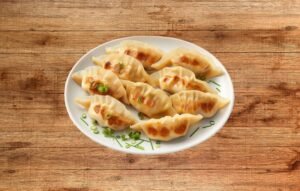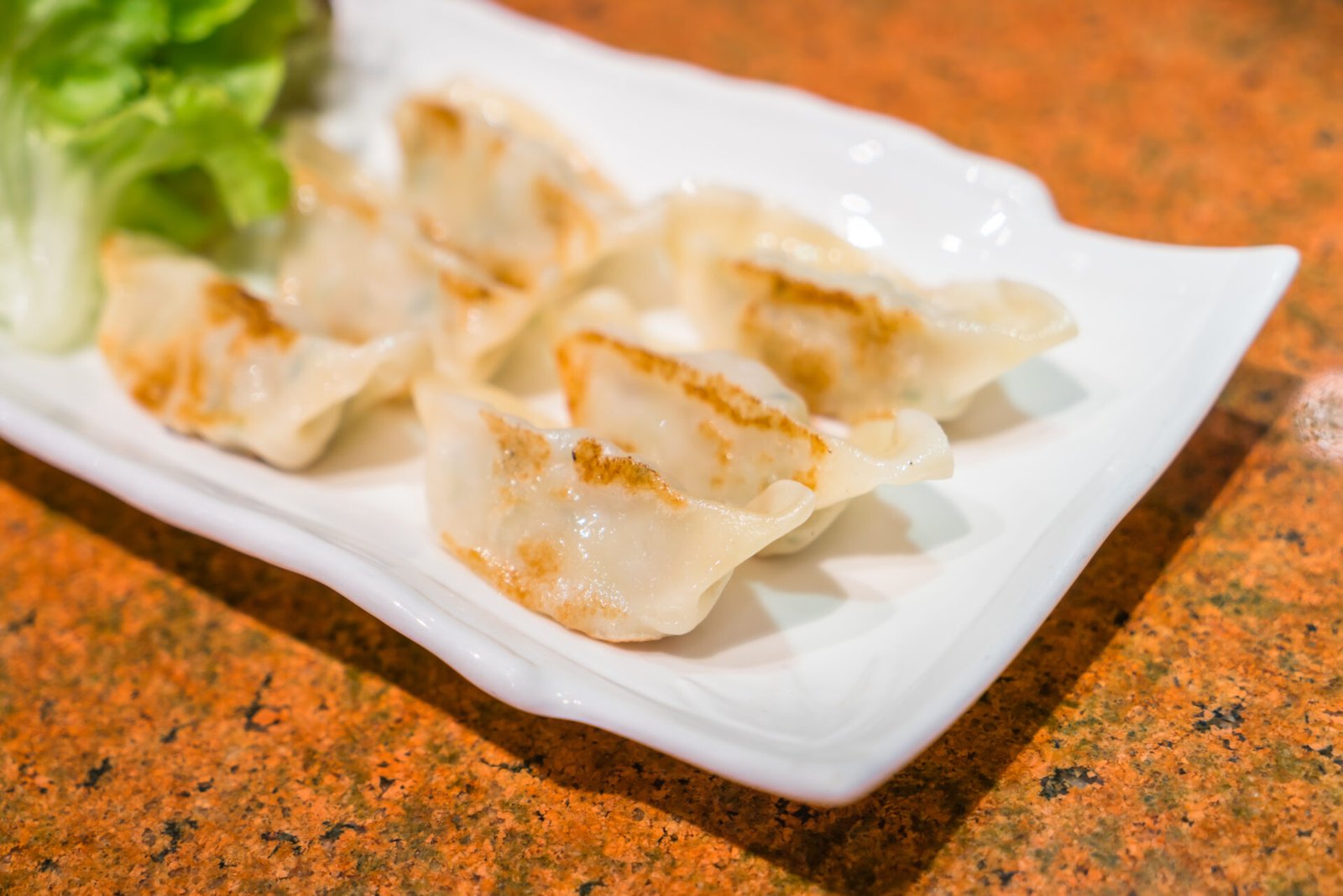Gyoza

Making gyoza from scratch can be a delightful culinary adventure! Here’s a detailed recipe to guide you through the process:
Ingredients:
For the filling:
– 250g ground pork (you can also use chicken or turkey)
– 2 cups finely chopped cabbage
– 2-3 green onions, finely chopped
– 2 cloves garlic, minced
– 1 tablespoon grated fresh ginger
– 1 tablespoon soy sauce
– 1 tablespoon sesame oil
– 1 teaspoon sugar
– Salt and pepper to taste
For assembling the gyoza:
– Gyoza wrappers (you can find these in the refrigerated section of Asian grocery stores)
– Water (for sealing the wrappers)
For cooking:
– Vegetable oil (for frying)
Instructions:
Preparing the filling:
1. The first step in the process is to get read the cabbage for the recipe. Cube it very small and add to a large salad bowl.
2. Season the cabbage with a little bit of salt and let it rest for five to 10 minutes. After that, take the cabbage by both of your hands and twist it to somewhat force out the additional water.
3. Mix the ground pork, chopped green onions, minced garlic, grated ginger, soy sauce, sesame, oil, sugar, salt, and pepper to the bowl with the cabbage.
4. Combine the ingredients well and ensure that they are thoroughly blended together. This can be done using a spoon or your hands without having to wash them before serving the food. Let it rest as you arrange the wrappers needed for a specific filling.
Assembling the gyoza:
1. Put a piece of gyoza wrapper on a plain area and make sure that there is no liquid on it.
2. Put roughly a tablespoon of the filling in the middle of the wrapper, making a small circle.
3. Take your finger and wet the border of the wrapper with your finger in a glass of water.
4. Place the mashed potatoes and tuna in the middle of the wrapper and top it as desired then, fold the wrapper in half making a half moon shape.
5. Pinch the edges of the gyoza to firmly seal them by making a little circle around the edges of the gyoza. You can further fold some parts inwards to give the edge a crimped look in the design of your choice.
6. Do the same with the remaining wrappers and filling until all gyoza is prepared to serve and enjoy the dish!
Cooking the gyoza:
1. Warm 1 tablespoon vegetable oil on a large non-stick skillet on medium heat.
2. Although the process takes time, it ensures that the meat turns brown evenly Once the oil is heated, pour the gyoza into the skillet to avoid having them stick together.
3. Then, cook the gyoza for about 2-3 minutes or until the bottom part becomes completely brown.
4. Slowly add 120ml of water into the skillet, and then place the lid on top of it with in the next few seconds. This will generate steam to cook the gyoza as shown below The gyoza should be steamed for not less than 20 minutes to make sure they are well cooked.
5. Cook the gyoza for another 4-5 minutes, or until the casing is translucent and the filling is cooked through.
6. Remove the lid and drain any remaining water. Cook the gyoza for a minute or two, until the bottom is crispy again.
7. Once the gyoza is cooked, place on a turkey plate and heat with your favorite dipping sauce like soy sauce mixed with rice vinegar and a dash of chilli oil.
Enjoy your own homemade gyoza! They are perfect as a snack or main course, and are sure to impress your family and friends. Gyoza on table

Calories in Gyoza
Gyoza, also known as potstickers or dumplings, has a rich history and several potential health benefits.
History of Gyoza:
1. Origin: Gyoza is only speculated to be a dish that has its origin in China and was later brought to Japan. This food type was known in Chinese as “jiaozi”, which can be translated as “wrap; dumplings”; it was a kind of filled pastry based on dough stuffed with minced meat and vegetables and steamed.
2. Introduction to Japan: Pervasive locally made foods include; Gyoza which was adopted into Japan during the late 1800s or early 1900s. The Japanese saw it fit to change it in every way possible though the most significant change occurred under the cooking process. Unlike TCM where the usual condiment for dumplings is steaming, Japanese dumplings called gyoza are typically cooked by frying, a layer on the bottom thus turns to crispy.
3. Evolution in Japan: Seasonings for Japanese gyoza usually involves cabbage and various kinds of meats, pork being the most popular, garlic, ginger and green onions. The dish spread like wildfire in Japan, and so it is relished in many parts of the globe today.
Health Benefits of Gyoza:
1. Protein: It usually is a kind of dumpling and it commonly has a protein meat stuffing that may include ground pork or chicken or shrimp among other things. Protein needs must be met because it’s the vital nutrient that is needed to rebuild and grow muscles after exercise, and for the proper functioning of the entire body.
2. Vegetables: Comparison: Vegetables are also incorporated into gyoza especially cabbage, garlic and ginger in the stuffing. These vegetables contain vitamin A, C and K, potassium and fiber – necessities for health and proper digestion.
3. Moderate Caloric Content: In terms of calorie content, gyoza is reasonable for a dish, but the number of calories does depend on what is in the filling and how the gyoza is cooked on the stovetop, frying pan or deep-fryer.
4. Cultural Significance: Sharing food together like gyoza has benefits on the human mind because they derive joy and happiness from eating with friends and families. The process of eating together with others creates a bond and makes them feel that they are in company or that they are not alone.
5. Versatility: It can be made with different fillings and wrapper dough; this makes it possible for different persons depending on their dietary needs to have the gyoza prepared to their preference. For instance, vegetarian or vegan fillings may be employed and biscuits with gluten-free components may be selected for customers with gluten allergies.
While gyoza can be a delicious and nutritious addition to a balanced meal, gyoza consumed in moderation as part of a varied and balanced meal, with attention to portioning required and cooking methods to provide optimal health benefits can contribute to overall good health.
Also read: Chilli Garlic Sauce

